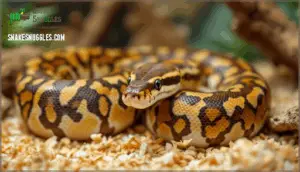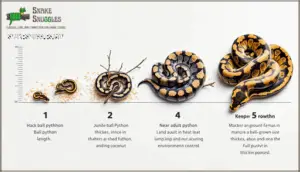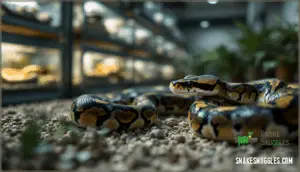This site is supported by our readers. We may earn a commission, at no cost to you, if you purchase through links.
 Most people think ball pythons stay small enough to fit in a shoebox. That’s not quite right. While males max out around three feet, females can stretch past five feet—a significant difference that shapes everything about their care.
Most people think ball pythons stay small enough to fit in a shoebox. That’s not quite right. While males max out around three feet, females can stretch past five feet—a significant difference that shapes everything about their care.
Your snake’s final size depends on gender, genetics, and how you raise it, and knowing what to expect makes all the difference between a thriving python and one struggling under the wrong conditions.
Understanding ball python growth patterns helps you prepare the right enclosure, feed appropriately, and catch health problems early.
Table Of Contents
- Key Takeaways
- Ball Python Growth Rate
- Male Ball Python’s Growth Rate
- Female Ball Python’s Growth Rate
- How Large Can a Ball Python Grow?
- How Long Does It Take for a Ball Python to Grow Fully?
- When Do Ball Pythons Reach Sexual Maturity?
- Ball Python Growth Chart
- Factors That Influence Ball Python’s Size
- How Do I Weigh a Ball Python?
- How to Avoid Obesity in Ball Pythons?
- Frequently Asked Questions (FAQs)
- What is the average lifespan of a ball python?
- What temperatures should a ball python’s enclosure be?
- What is the ideal humidity for a ball python?
- What kind of food should I feed my ball python?
- How often should I handle my ball python?
- Can ball pythons continue growing after reaching adulthood?
- What signs indicate a ball python is growing normally?
- Conclusion
Key Takeaways
- Females grow roughly 1.5 times faster than males and reach 4–6 feet by age 3–5, while males max out around 3–3.5 feet by age three, making enclosure planning dependent on your snake’s gender.
- Temperature, feeding frequency, enclosure size, and genetics collectively determine final size—genetics set the ceiling, but proper husbandry lets your python reach its full potential.
- Feed juveniles weekly and adults every 7–10 days with appropriately sized prey (10–15% of body weight for young snakes, 5% for adults) to support steady growth without triggering obesity.
- Monitor weight monthly at least 48 hours after feeding using a digital scale; weight fluctuations exceeding 10% warrant veterinary attention, and consistent monthly gains signal normal development.
Ball Python Growth Rate
Your ball python grows fastest in its first few years of life. During early growth stages, hatchlings measuring just 10-17 inches rapidly expand through the juvenile phase. Females grow considerably faster than males—gaining 12-16 inches yearly compared to males’ 8 inches annually. This seasonal growth pattern continues until around age three, when your snake reaches full adult size.
Captive growth usually progresses predictably: hatchlings reach 150-300 grams by six months, then 300-600 grams by one year. A healthy hatchling averages about 86 grams. Understanding these growth stages helps you provide proper nutrition and monitor whether your ball python is developing normally for its age and sex.
Male Ball Python’s Growth Rate
Male ball pythons follow a predictable growth trajectory during their first few years. They gain roughly 8 inches annually until reaching sexual maturity around age three. This steady pace reflects their smaller genetic potential compared to females, though individual variation remains significant based on diet and care.
Your male ball python usually measures between 2.5 to 3.5 feet at full maturity, weighing 1.2 to 1.6 kilograms. Growth benchmarks matter here—expect hatchlings around 25-43 centimeters to reach 700-1,000 grams within the first year under prime conditions. By 18-24 months, most males hit 1,000-1,500 grams as growth rate begins slowing after the first year.
Key factors shaping male growth rates:
- Feeding frequency and prey size directly impact weight gain; consistent feeding every 10-14 days optimizes growth without promoting obesity
- Environmental temperatures between 26-32°C support digestion and maintain linear growth progression through adolescence
- Genetic potential determines whether your male reaches the upper or lower end of the usual size range
Males achieving sexual maturity early (700-800 grams) sometimes show reduced subsequent growth compared to later-maturing individuals. Ball pythons use their heat-sensing labial pits to detect prey. Understanding these growth stages helps you track whether your snake develops normally.
Female Ball Python’s Growth Rate
Unlike males, female ball pythons grow roughly 1.5 times faster, gaining 12 to 16 inches yearly during their growth phase. Your female hatchling starts around 10 to 17 inches and 45 to 80 grams, then gains 400 to 1,000 grams in that first year—sometimes 70 to 100 grams monthly. By year two, she’ll weigh 800 to 1,800 grams, and by three years, usually 900 to 2,000 grams. Sexual maturity arrives around 27 to 31 months.
Proper feeding schedules, temperatures between 84 to 86°F, and genetics all shape how quickly she reaches her potential. Growth slows after the third year as she approaches full size.
How Large Can a Ball Python Grow?
Ball pythons don’t stay tiny for long. While males usually max out around 3 to 3.5 feet, females grow considerably larger, reaching 4 to 6 feet on average.
Understanding the full size range of your snake helps you plan ahead for proper housing and care as it matures.
Male Ball Python’s Length and Weight
At maturity, your male ball python will generally reach 3 to 3.5 feet in length and weigh around 700 to 800 grams—noticeably smaller than females. Most males hit this average male size by age three, though growth varies based on several factors.
Here’s what shapes their captive male size:
- Genetics play the primary role in determining your male ball python’s potential length and maximum weight
- Diet quality and feeding frequency directly affect male weight gain and overall growth rate during early years
- Environmental conditions—including enclosure temperature and humidity—influence metabolic efficiency and male growth factors
Understanding these male size genetics helps you provide appropriate husbandry and recognize whether your snake is developing normally on the ball python growth rate and size chart.
Female Ball Python’s Length and Weight
Your female ball python will reach up to 5 feet in length and weigh around 1.6 to 2.5 kilograms at maturity. Females grow considerably faster than males, gaining roughly one foot per year during their first few years. This size difference is driven by genetics and reproductive physiology—females need larger bodies to support egg production.
What influences female growth:
- Genetics determine her maximum length potential and growth ceiling
- Diet quality and feeding frequency directly affect weight gain and development speed
- Environmental temperature and humidity alter her metabolic efficiency
- Enclosure size allows for natural movement that builds muscle and frame
Your female may reach the maximum female weight of 3 kilograms in a gravid state before breeding. Understanding the female ball python size chart helps you track whether she’s developing normally. Proper husbandry during female growth spurts makes certain she reaches her full potential while staying healthy throughout her lifespan.
How Long Does It Take for a Ball Python to Grow Fully?
How quickly does your ball python reach full size? With proper care, most ball pythons complete their growth within three to five years. Here’s what drives the maturity timeline:
- Early rapid growth — Hatchlings double in length and increase tenfold in weight within the first 12 months.
- Steady juvenile phase — Ages 1–3 bring consistent gains of 300–500 grams annually.
- Slower near-adult stage — By year 3–5, growth levels off considerably as they approach adult size.
- Females mature later — They usually need the full five years to reach their 4–6 foot potential.
- Males finish sooner — Most reach their 2.5–3.5 foot maximum by year three.
Temperature, feeding frequency, and genetics all influence these ball python growth stages. Maintain consistent warmth between 84–86°F and feed appropriately sized prey weekly to support steady development. Substandard conditions—cold enclosures or irregular feeding—can delay reaching full size by months or more.
Once fully grown around age five, your snake enters a plateau phase with minimal annual increases, though subtle lifelong growth continues throughout its 20–30 year lifespan.
When Do Ball Pythons Reach Sexual Maturity?
When does your ball python become ready to breed? Males reach sexual maturity around 16 to 18 months, usually weighing at least 500 grams. Females mature later—between 27 to 31 months—and need 1,200 to 1,500 grams before breeding safely. Size matters as much as age. Even if a male or female reaches the right age, insufficient body mass delays reproductive capability.
Wild ball pythons breed during the minor rainy season from mid-September through mid-November, triggered by cooling temperatures and reduced daylight. In captivity, many breeders replicate these seasonal cues to synchronize breeding cycles.
Both sexes remain reproductive for 27 to 30 years, though fertility gradually declines with age.
Ball Python Growth Chart
Your ball python’s growth unfolds in predictable stages. Hatchlings arrive at 10–17 inches and 50–100 grams, then enter a rapid juvenile phase where they gain 50–100 grams monthly, reaching 500–1,000 grams by age one. During the sub-adult stage (ages 1–3), growth continues at 300–500 grams annually. Males generally plateau at 2.5–3.5 feet and 800–1,600 grams, while females keep expanding to 4–5.5 feet and 1,200–2,500 grams. Full maturity arrives around year three for males and year four for females. This growth comparison shows females gain roughly 30–40% more weight than males of equivalent age.
| Age | Length | Weight |
|---|---|---|
| 3 months | 35–45 cm | 150–250 g |
| 6 months | 50–70 cm | 400–600 g |
| 1 year | 60–90 cm | 500–1,000 g |
| 2–3 years | 90–120 cm | 1,000–1,500 g |
| 3–5 years | 90–150 cm | 1,200–2,500 g |
Factors That Influence Ball Python’s Size
Your ball python’s size depends on more than just how old it is. Several key factors work together to shape how big your snake will grow, from the moment it hatches to adulthood.
Let’s look at what actually drives these differences.
Gender
Gender creates the most striking differences in ball python size. Females grow roughly 1.5 times faster than males, reaching 4 to 5.5 feet compared to males’ 3 to 3.5 feet. This sexual dimorphism means female ball pythons commonly weigh 1,500 to 3,000 grams as adults, while males average 1,200 to 1,800 grams.
Males reach sexual maturity around 18 months, though females need an additional six months before breeding readiness. Understanding these gender genetics helps you anticipate your snake’s adult size and breeding potential.
Genetics
Your ball python’s size potential begins before you even bring them home. Genetics shape everything—certain morphs and bloodlines consistently produce larger adults, while selective breeding has created snakes that exceed the typical 5-foot range. Geographic origin matters too; wild-type pythons from different Sub-Saharan African regions adapted to varying prey availability, influencing their adult size.
Offspring from larger parents usually hatch heavier and grow faster early on. Beyond ancestry, metabolic traits inherited from parents affect both growth rate and maximum size.
Think of genetics as your snake’s growth blueprint—it sets the ceiling for what your individual python can achieve, even with perfect care.
Genetics sets your snake’s growth ceiling, but husbandry determines whether it reaches that potential
Husbandry
Genetics sets your snake’s growth blueprint, but husbandry determines whether it reaches that potential. Temperature, feeding, and enclosure conditions directly shape how large your ball python becomes.
Maintain a thermal gradient of 75–92°F and humidity around 50–60% to support healthy digestion and growth. Feed appropriately sized prey on a consistent weekly schedule, adjust frequency by age, and keep your enclosure clean. These factors work together—skip any one, and your snake’s growth stalls.
The right environment lets your python thrive; poor conditions suppress appetite and slow development.
Enclosure Size
Your enclosure size directly impacts how much room your ball python has to move and grow. Adult ball pythons need a minimum of 36 inches in length, but larger habitats foster better muscle development and activity levels. Aim for an enclosure at least 1.5 times your snake’s body length to minimize stress and healthy growth.
- Minimum dimensions prevent cramped conditions that suppress appetite and slow development
- Vertical space allows natural climbing actions that strengthen muscles
- Substrate depth of 2–3 inches burrowing instincts and reduces stress
- Custom enclosures matching your python’s size encourage exploration and activity
Snakes kept in appropriately sized enclosures develop stronger bodies and reach their genetic potential more readily than those confined to cramped spaces.
Diet
What you feed your ball python matters far more than you might think. Appropriately sized prey—mice for hatchlings, rats for adults—fuels growth at each life stage.
Feed juveniles weekly and adults every 7–10 days to support steady development without triggering obesity. Include calcium and vitamin D3 supplements to strengthen bones. Frozen-thawed prey beats live food for safety.
Underfeeding stunts growth; overfeeding creates overweight snakes prone to health issues. Match portions to your python’s size and age, and you’ll see consistent, healthy gains year after year.
How Do I Weigh a Ball Python?
Now that you understand what drives your ball python’s growth, monitoring its weight becomes your window into its overall health. A digital kitchen scale gives you the precision you need—one that measures up to 10,000 grams works perfectly for adults averaging 1,000–3,000 grams. Look for models with a tare function so you can zero out the container weight before adding your snake.
Here’s how to do it right:
- Scale selection – Choose a digital scale with gram-level accuracy and a tare button for reliable, consistent readings.
- Measurement timing – Weigh your snake at least 48 hours after feeding to avoid food weight skewing results.
- Careful holding – Place your python in a calm, ventilated container on a flat surface, minimizing stress and movement during the process.
- Data logging – Record weights monthly in a spreadsheet to track growth patterns and spot sudden changes that signal health concerns.
Weight fluctuations exceeding 10% warrant veterinary attention. Consistent, gradual increases align with normal development.
How to Avoid Obesity in Ball Pythons?
Obesity creeps up silently in captive ball pythons, but you can stop it before it starts. The key is balancing feeding frequency with movement and monitoring. Feed juveniles every 5–7 days and adults every 10–21 days, keeping prey at 10–15% of body weight for young snakes and 5% for adults. Power feeding causes fatty liver disease and cuts lifespan in half.
Here’s your action plan:
- Feeding Frequency – Stick to appropriate schedules; snakes fed twice weekly receive over 10 times their natural annual meal rate.
- Enclosure Enrichment – Add climbing structures and varied terrain to encourage movement; your python needs space equal to its full body length.
- Weight Monitoring – Weigh monthly with a digital scale 48 hours after feeding to catch abnormal gains early.
- Dietary Variety – Offer nutritionally balanced prey in appropriate sizes to prevent excess fat accumulation and nutrient imbalance.
Track progress consistently. A healthy weight trend over months signals your feeding and exercise balance is working.
Frequently Asked Questions (FAQs)
What is the average lifespan of a ball python?
Ball pythons are like long-term investments—they require patience and dedication. In captivity, they usually live 20–30 years with proper care, though some exceed 40 years. Wild lifespan factors differ greatly.
Common ailments, temperature management, and diet directly impact longevity. Extending lifespan means prioritizing consistent husbandry, regular veterinary check-ups, and appropriate feeding schedules throughout their growth and adult years.
What temperatures should a ball python’s enclosure be?
Your ball python’s enclosure needs a warm side of 78-80°F during the day and a cool side of 70-75°F at night. A basking spot around 88-92°F helps with digestion.
Use a reliable thermometer to monitor temperatures accurately, and consider under-tank heaters or heat tape as heating methods.
This temperature gradient lets your snake thermoregulate naturally.
What is the ideal humidity for a ball python?
Getting humidity right keeps your snake thriving. Aim for 50-60% humidity in your ball python’s enclosure—that ideal range prevents respiratory infections while supporting healthy shedding.
Use aspen or cypress substrate, provide fresh water daily, and mist occasionally to maintain hydration levels. Monitor humidity with a reliable gauge and adjust misting frequency based on your snake’s shedding patterns and enclosure conditions.
What kind of food should I feed my ball python?
Your ball python needs appropriately sized prey to support healthy growth. Feed hatchlings small mice every 5-7 days, while adults eat rats weekly.
Use frozen-thawed prey for safety, and include calcium and vitamin D3 supplements to prevent nutritional deficiencies.
How often should I handle my ball python?
Interact with your ball python several times weekly, but wait 24-48 hours after feeding to avoid regurgitation. Keep sessions under 20 minutes to minimize stress.
Regular, careful interaction builds temperament and lets you monitor health, but respect your snake’s signals and avoid interaction during shedding or illness.
Can ball pythons continue growing after reaching adulthood?
After reaching adulthood around three years old, your ball python’s growth largely plateaus. They won’t grow noticeably larger, though continued shedding and lifelong environmental changes can affect their appearance.
Adult ball python size remains relatively stable, but factors influencing growth rate become less relevant once maturity sets in.
What signs indicate a ball python is growing normally?
How can you tell your ball python is thriving? Watch for consistent weight gain month to month, regular shedding in one piece, maintained appetite, and active daytime habits.
These signs show normal growth and healthy development aligned with your ball python growth chart expectations.
Conclusion
Don’t let size assumptions trip you up. How big do ball pythons get? Males generally reach three feet, while females often surpass five feet—a key distinction that determines enclosure needs, feeding schedules, and long-term care requirements.
Understanding these growth patterns helps your python thrive rather than merely survive. Genetics, gender, and husbandry all play roles in final size, but proper preparation from day one sets the foundation for a healthy, appropriately-sized adult.
- https://www.reddit.com/r/snakes/comments/19pp8u/ball_pythons_real_size_difference_between_male/
- https://a-z-animals.com/animals/python/male-vs-female-ball-python-what-are-the-differences/
- https://ball-pythons.net/forums/showthread.php?40424-largest-ball-python-ever-recorded
- https://reptifiles.com/ball-python-care-guide/
- https://www.petmd.com/reptile/ball-python-care-sheet














